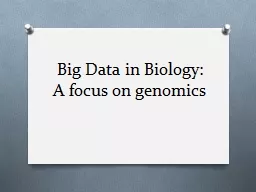

Bioinformatics and Genomics Applications Personalized cancer medicines Disease determination Pathway Analysis Biomarker Discovery An Interesting Point One article estimated that the output from genomics may soon dwarf data heavyweights such as ID: 482603
Download Presentation The PPT/PDF document "Big Data in Biology: A focus on genomics" is the property of its rightful owner. Permission is granted to download and print the materials on this web site for personal, non-commercial use only, and to display it on your personal computer provided you do not modify the materials and that you retain all copyright notices contained in the materials. By downloading content from our website, you accept the terms of this agreement.
Slide1
Big Data in Biology: A focus on genomicsSlide2
Bioinformatics and Genomics
Applications:
Personalized cancer medicines
Disease determination
Pathway Analysis
Biomarker Discovery Slide3
An Interesting Point
“One
article estimated that the output from genomics may soon dwarf data heavyweights such as
YouTube”
“I don't know if a million genomes is the right number, but clearly we need more than we've got,” says Marc Williams, director of the
Geisinger
Genomic Medicine Institute.Slide4
Stephens, Z. D. et al.
PLoS
Biol.
13
, e1002195 (2015)Slide5
Genomics in the Past
DNA can have 4 different bases, A, C, G, T
Exons (1%): parts of the DNA that code for proteins
Look at nucleotides
~13,000 single nucleotide variants.
Roughly 2% of these will affect protein
composition
Unfortunately, research used cell cultures or animal modes.
However:
Many of these associations were made with low levels of evidence. Slide6
Genomics Continued
Structural Variants – deletion, duplication, and translocation.
Much harder to detect than single mutations
Many genes do not code for proteins, but can still regulate protein creation, but it’s still not well known the function of many of these regions.
Capturing all such variation is desirable, but not the best in the short term
Tldr
;
genomics is hard.Slide7
Applications
Iceland
deCODE
Project: medical history records and genome data of 150,000 people
Led to Discovery of:
Genetic risk factors
Breast cancer
Alzheimer’s
Also
found 10,000 people missing 1,500 different copies of both genes.
Drug responsiveness:
ADHD medicine only works for one of ten preschoolers, cancer drugs are effective for 25% of patients, and depression drugs work with 6 of 10
patients.
Personalized MedicineSlide8
Issues with Bioinformatics
Icelandic work helped by a homogeneous population.
1000 Genomes project captured some diversity, but mainly captured Caucasian populations.
“Because they come from the genetic mother ship, so to speak, people of African ancestry carry a lot more genetic variants than non-Africans… Variants that seem unusual in Caucasians might be common in Africans, and may not actually cause disease.” - says Isaac
Kohane
, a
bioinformatician
at Harvard Medical School in Boston, Massachusetts.
Reference genome: the comparison tool that many researchers use is flawed.
1
st
iteration: random donors of unidentified ethnicity.
Currently it incorporates more human genomic diversity.Slide9
Solutions
Relationships between doctors and researchers to create models between diseases and genetics.
Harvesting genomes produces up to 40 Petabytes (PB) per a year.
Computational power: The
more variables you add, the more people you add, it gets harder and harder.
Silicon Valley Lure: people needed for bioinformatics need to be able to harness massive parallel computation. Slide10
Conclusion
Two Main Issues:
Difficulty of bioinformatics due to genomics
Computational power and the need for collaboration
Yet solving these problems, could easily lead to incredible improvements in medicine.